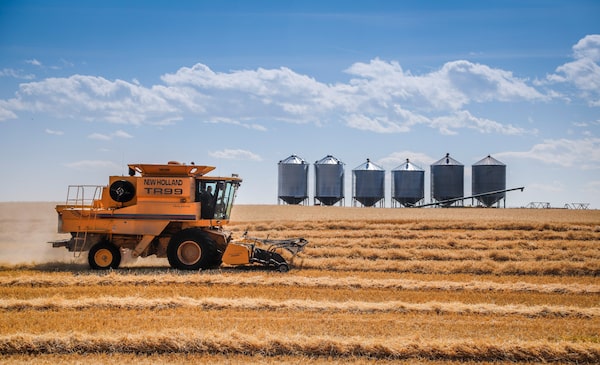
A combine harvests a wheat crop near Cremona, Alta., on Sept. 9, 2021.Jeff McIntosh/The Canadian Press
The price of wheat is down almost 30 per cent from a year ago but appears to be bottoming. Where do we expect wheat prices to be going forward and what factors are influencing it?
Global wheat production is concentrated in China, at 137 million tonnes, the European Union at 134, India with 103 and Russia at 92. The United States produces 45 million tonnes and Canada’s annual wheat production ranks sixth globally at 34 million tonnes. Russia, the U.S., Australia and Canada have the largest volume of wheat available for trade at 51, 28, 25 and 22 million tonnes, respectively.
More than 50 per cent of Canada’s wheat export leaves through the Port of Vancouver, heading for Asian markets. Russia has been expanding its wheat exports into the West by charging lower prices to offset the cost of longer shipping distances. Despite Western sanctions, Russian wheat exports are up considerably from levels before the invasion.
The International Grain Council provides good insight into global production and consumption expectations for 2024-25. Production is forecast at 788 million tonnes, up slightly from the prior year, and consumption is projected to be flat at 804 million tonnes. (Wheat in storage makes up the difference.) Consumption has increased about five million tonnes per year on average over the past decade. This will be the fourth year in a row consumption will exceed production, a dynamic that leads to higher prices. The IGC sees better yields more than compensating for a modest pullback in acreage. Of the 788 million tonnes of production, 198 is expected to be available for trade, with the balance used for domestic consumption.
Wheat is classified based on growing season, hardness, colour and shape. To understand the wheat balance in North America, there is a large difference between the amount of winter and spring wheat in Canada and the U.S. Winter wheat is seeded in the fall, harvested in the spring, and comprises approximately two-thirds of wheat grown in the U.S., according to the U.S. Department of Agriculture. (Spring wheat is planted in the spring and harvested in the fall.) In Canada, only 8 per cent of wheat produced is winter wheat, with production concentrated in Southern Ontario. Hard winter wheat is used to make French, flat and steamed breads as well as noodles, while soft winter wheat is used for cakes, pastry, cereal, crackers and biscuits. With its high protein content and workability, Canada Western Red Spring Wheat’s characteristics make it ideal for the production of high-volume pan breads and rolls.
Price
We are approaching the second anniversary of the Russian invasion of Ukraine. Wheat prices spiked during the invasion, climbing to US$13 per bushel. Prices have now retreated back to the US$6-per-bushel range. In July, Russia pulled out of the Black Sea grain initiative, a deal which had guaranteed safe passage for grains produced in Ukraine. Since that time Ukraine has moved grains along the western end of the Black Sea as Russia has moved patrol ships, landing vessels and frigates closer to its eastern ports after repeated attacks on its fleet.
In June of 2023, the Chicago Mercantile Exchange launched the cash-settled Canadian Western Red Spring Wheat (Platts) futures contract based on Vancouver port location. With 92 per cent of Canada’s wheat being planted in the spring, and the majority of that being Canada Western Red Spring, the launch of that futures contract offers a tool for farmers to hedge their exposure to Canadian Western Red Spring Wheat markets.
Durum
Durum is the hardest of all wheats and has a high protein content that is excellent for pasta. In November, Russia said it was banning exports of durum wheat because of tight supplies. We are seeing a shortage of durum wheat globally, caused primarily by weather conditions in North America and Europe. Globally, over the past five years, there has been about 32 million tonnes of durum production, compared with 34 million tonnes of consumption each year.
Canada typically accounts for about half of the world’s durum wheat trade and 15 per cent of global production. According to Agriculture Canada, in the 2023-24 growing season, Canadian durum production dropped 30 per cent from the previous year to four million tonnes because of dry conditions in the southwest Prairies. For the 2024-25 season, it forecasts production to improve to 5.4 million tonnes with a larger area seeded and yields are expected to improve from 2023 levels.
Longer term weather outlook
El Nino has been driving our weather pattern for the past year now. We are seeing talk of a shift to La Nina, a colder weather pattern which typically brings with it more precipitation and wind, emerging later this summer. That weather shift should help the next two growing seasons in the Prairies.
More about the author
Brian Donovan, CBV, is the president of StockCalc, a Canadian fintech based in Miramichi, N.B.
Be smart with your money. Get the latest investing insights delivered right to your inbox three times a week, with the Globe Investor newsletter. Sign up today.